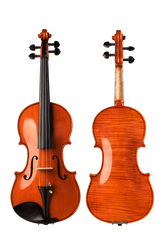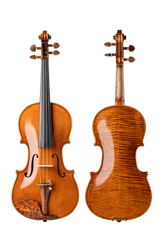Why Is Violin Tuning So Difficult? Causes & Practical Solutions for Beginners
For many violin beginners, tuning the instrument is one of the most frustrating tasks.
You tune the violin… and minutes later it goes out of tune again.
New strings never seem stable.
During winter the violin becomes much harder to tune.
These issues are extremely common, and all of them have clear reasons.
In this guide, we break down the five major causes of violin tuning problems and provide simple, practical solutions suitable for beginners and parents.
1. Player-Related Factors (Beginner Ear Training & Tuning Technique)
Common Problems
The biggest challenge for beginners is the lack of:
-
A stable sense of pitch
-
Understanding when to use fine tuners vs. pegs
-
The patience needed to adjust pitch slowly
Beginners often overshoot the pitch or cannot tell whether the note is too high or too low.
Solutions
Develop Your Ear
-
Use a clip-on tuner or tuning app
-
Tune before and after every practice session
-
Try memorizing the standard pitch of A4 (440 Hz)
Consistency will naturally improve your pitch accuracy.
Learn the Correct Tuning Method
-
Always tune A → D → G → E
-
Fine tuners = small adjustments
-
Pegs = large adjustments
-
Turn slowly and carefully
2. Temperature & Humidity (The Most Sensitive Factor for Violins)
Why It Happens
Violins are wooden instruments. Wood expands and contracts with environmental changes:
-
High humidity → wood expands → strings loosen → pitch goes lower
-
Low humidity → wood contracts → strings tighten → pitch goes higher
-
Moving the violin between indoor and outdoor environments causes rapid tuning changes
This is why even professional violinists repeatedly tune during rehearsals and concerts.
Solutions
Control Humidity (40–60%)
-
Use a hygrometer inside the violin case
-
Use a humidifier or Dampit in dry seasons
-
Use desiccants in humid seasons
-
Avoid heating vents, AC airflow, or direct sunlight
Handle Temperature Changes Properly
-
Allow the violin to rest in the case for 15–30 minutes after coming indoors
-
Let the violin adjust to the room before tuning and playing
3. Peg Issues (Peg Slipping or Sticking)
Common Problems
Pegs control major pitch adjustments, but they require technique:
-
Not pushing inward causes the peg to slip
-
Pushing too hard causes it to stick
-
Incorrect friction inside the pegbox leads to instability
Solutions
Correct Use of Pegs
-
Turn while gently pushing inward
-
Make tiny adjustments
-
Tighten (pitch up) by turning inward; loosen (pitch down) outward
Peg Maintenance
-
Peg slipping → apply peg compound
-
Peg too tight → apply a little graphite (pencil lead)
-
Persistent issues → consult a luthier
Beginner Recommendation
Install four fine tuners to make tuning dramatically easier.
4. New Violins Need a Break-In Period (3–6 Months)
Why It Happens
A new violin needs time to adapt to:
-
Continuous string tension
-
Environmental humidity
-
Vibrations from playing
Wood and glued joints slowly stabilize over several weeks or months.
Solutions
-
Play the violin more frequently during early weeks
-
Expect to tune 2–3 times a day during the first two weeks
-
Store the violin in a stable environment
This process is normal and temporary.
5. New Strings Stretch and Cause Frequent Tuning Instability
Why It Happens
New strings require time to stretch and settle.
During the first 24–72 hours, strings may go flat repeatedly.
Different materials stabilize at different speeds:
-
Synthetic strings: 3–5 days
-
Steel strings: faster
-
Gut strings: the slowest
Solutions
Stretch New Strings Properly
-
After installing the string, gently lift it 1–2 cm
-
Slide fingers along the string from the bridge to the peg
-
Tune to pitch
-
Repeat 3–5 times
This reduces the break-in time significantly.
Best Practices When Replacing Strings
-
Do not change strings right before a performance
-
Replace strings one at a time
-
Choose stable, high-quality brands (Dominant, Evah Pirazzi, etc.)
Final Tips: Daily Maintenance & Proper Tools
Daily Care
-
Tune before every practice session
-
Replace strings every 6–12 months
-
Have a luthier check the violin every 1–2 years
Recommended Tools
-
Reliable clip-on tuner
-
Peg compound & graphite
-
Four fine tuners for easy tuning
Mindset Matters
Tuning is part of violin playing—even professional musicians tune constantly.
The more you tune, the better your ear becomes. Over time, tuning will feel natural, fast, and effortless.
Related articles recommended:
Violin Peg Problems: Causes and Solutions
Common Violin Tuning Issues And Fixes
Recommended handmade violins for November 2025

This violin is our new model released in November, handcrafted with European maple and spruce. If you are interested, feel free to reach out to us through the online chat on our website or leave a message on our Contact Us page. We will get back to you within 24 hours after receiving your inquiry.





